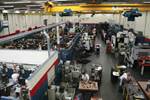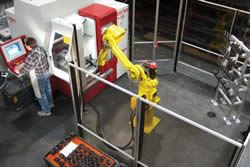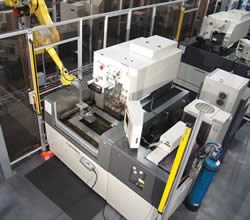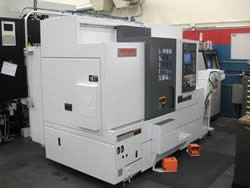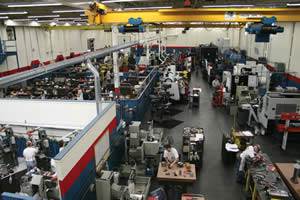Equipment Expansion Lands Additional Customers
Adding equipment to the shop floor not only accommodates existing customers, but also can serve as an investment in securing work from new customers.
When it comes to exploring new business opportunities by expanding your customer base, perhaps the first thought that comes to mind is not one of purchasing new equipment—especially during these challenging economic times. However, equipment expansion should be seriously considered as a way to tap into new markets—and thus find new customers.
MGS Mfg. Group (Germantown, WI)—a full-service provider of manufacturing solutions to the plastics industry—recently purchased a new Mori Seiki NL1500SY CNC lathe and a Fanuc six-axis robot that was installed on the company’s röders RXP 500 DS 5-axis machine. The 5-axis machine was incorporated on the shop floor last July for its electrode manufacturing cell. MGS Group Marketing Director John Berg points out that these equipment purchases are a “valuable and resourceful addition for the company and its customers”—improving leadtimes and overall efficiencies.
Other recent equipment purchases include Work NC (machining software for 5-axis) and CamWorks (plate machining software that runs inside SolidWorks). A Kitamura machining center also has been added to MGS Mfg.’s Prototypes, Molds, & Design (PMD) business group. “In our preventive maintenance tool shop (which supports our custom molding business divisions, we installed new 10-ton capacity cranes to enable our ability to service larger tooling systems,” Berg notes. “We continue to train personnel to reach the highest levels of tool development, maintenance and repairs. We also continue to develop updates in our computer data systems to achieve more accurate and complete records for tool development and preventive maintenance.”
Why Buy?
According to Berg, the decision to buy new equipment was a smart business decision that coincided with customer demand. “Two markets/industries have been growth sectors for us with regard to tooling: medical/healthcare and packaging/caps/closures—both of which demand the ability to produce rounds with consistent accuracy,” he explains. “We plan for the future.”
Dan Anderson, MGS High-Speed Machine Specialist, notes that tool shop efficiencies have shown marked improvement since the 5-axis machine was installed, and the addition of the robot has increased efficiencies through automation. “It allows us to cut more accurately, rigidly and at a faster pace.”
Berg adds that this new equipment “provides the ability to do more work in-house and better control the build schedules and assure timely delivery. The ability to tour customers and prospective customers through our shop and have them see—firsthand—the company’s investment in manufacturing technologies lends credence to our position of engineered quality and on-time delivery.”
Reaching New Markets
MGS uses a variety of methods to ensure the company’s capabilities are properly publicized and reaching the right audience. “We normally issue press releases when we make any type of investment that is attributable to increased service and efficiencies,” says Rebecca Reed, Marketing Manager for MGS. “We also give the technologies premium space on our Web site; and we have recently launched a new Web site (www.fiveaxismachining.com) that focuses on our machining capabilities using this technology. We also have revised our tooling group’s collateral material to reflect these expanded capabilities.”
Berg adds that the company’s increases in machining capacity and capabilities with these new systems have enabled MGS to attract new business from non-plastic injection mold customers. “It gives us additional opportunities with companies that were not our targets a year ago,” he emphasizes. “Thus, we are in a position to market ourselves to any company needing precisely engineered steel with integrated quality control.”
In conclusion, Berg shares the following pearls of wisdom. “Equipment is purchased to accommodate existing customer needs and as an investment in securing work from potential customers/industries,” he comments. “We are always evaluating our workflow in an effort to gain efficiencies and increase capacities without expanding floor space. Mold manufacturers must be keenly aware of all the related services they can provide to their customers. As companies consolidate their vendor base, it is imperative that we provide as many services as we can effectively manage to fulfill their needs.”
![]()
Related Content
MMT Chats: The Connection Between Additive Manufacturing Education and ROI
This MMT Chat continues the conversation with Action Mold and Machining, as two members of the Additive Manufacturing team dig a little deeper into AM education, AM’s return on investment and the facility and equipment requirements to implement AM properly.
Read MoreWhat is Driving Mold Lifecycle Management Digitalization?
OEMs are looking to partner with suppliers to share and track data across the supply chain for advanced intervention and process management.
Read MoreMachine Hammer Peening Automates Mold Polishing
A polishing automation solution eliminates hand work, accelerates milling operations and controls surface geometries.
Read MoreMaking Quick and Easy Kaizen Work for Your Shop
Within each person is unlimited creative potential to improve shop operations.
Read MoreRead Next
Going Green Can Garner New Business
Adopting green initiatives is not only important to your business, it is important to your customer and should be a part of your standard business practices.
Read MoreAre You a Moldmaker Considering 3D Printing? Consider the 3D Printing Workshop at NPE2024
Presentations will cover 3D printing for mold tooling, material innovation, product development, bridge production and full-scale, high-volume additive manufacturing.
Read MoreHow to Use Strategic Planning Tools, Data to Manage the Human Side of Business
Q&A with Marion Wells, MMT EAB member and founder of Human Asset Management.
Read More
